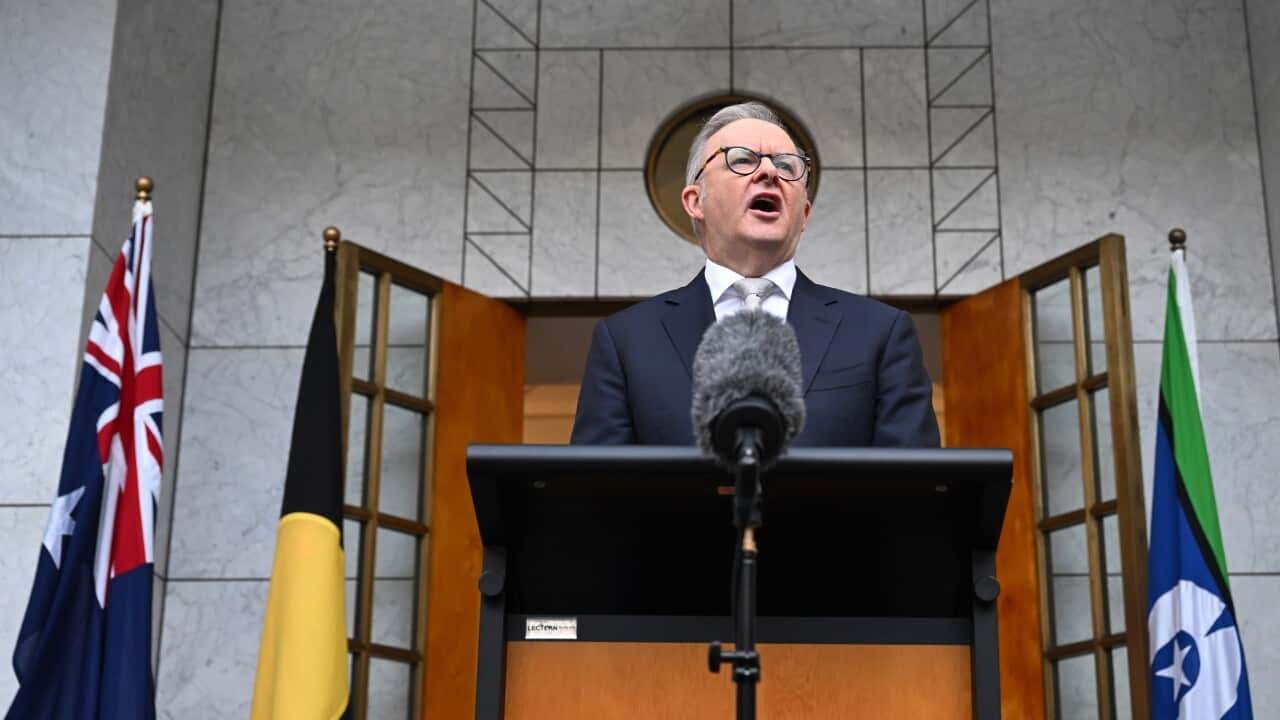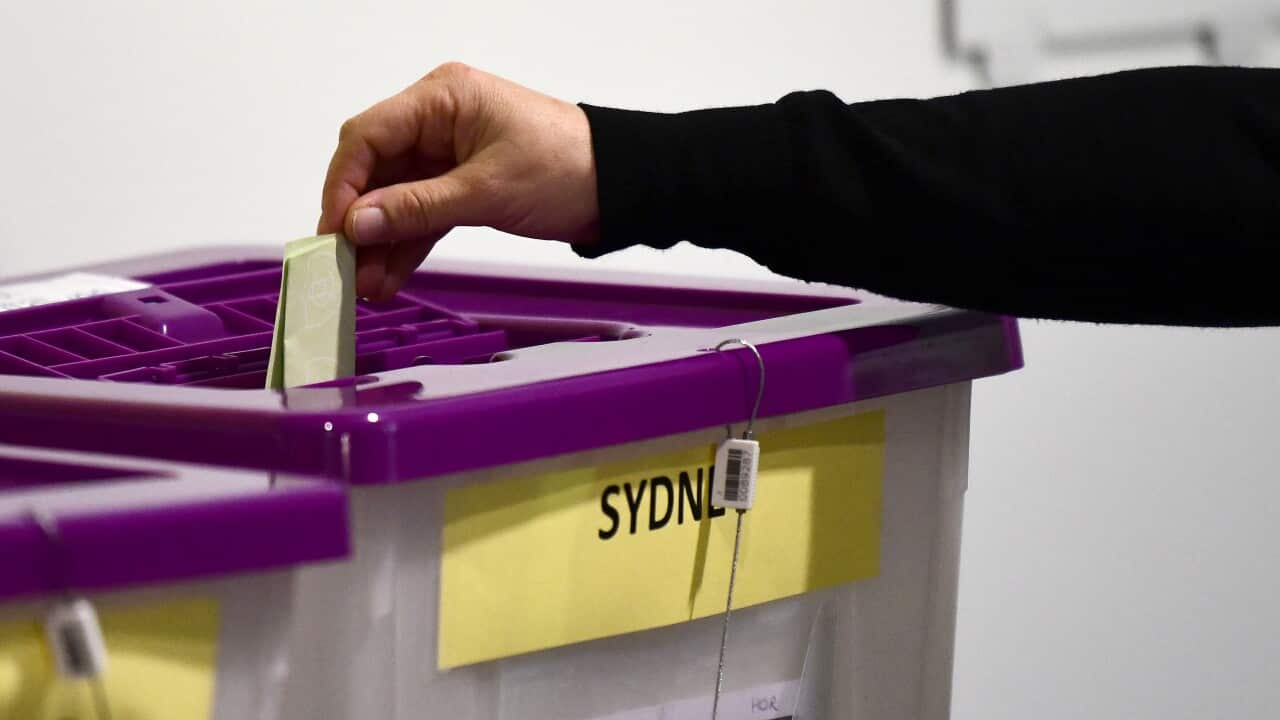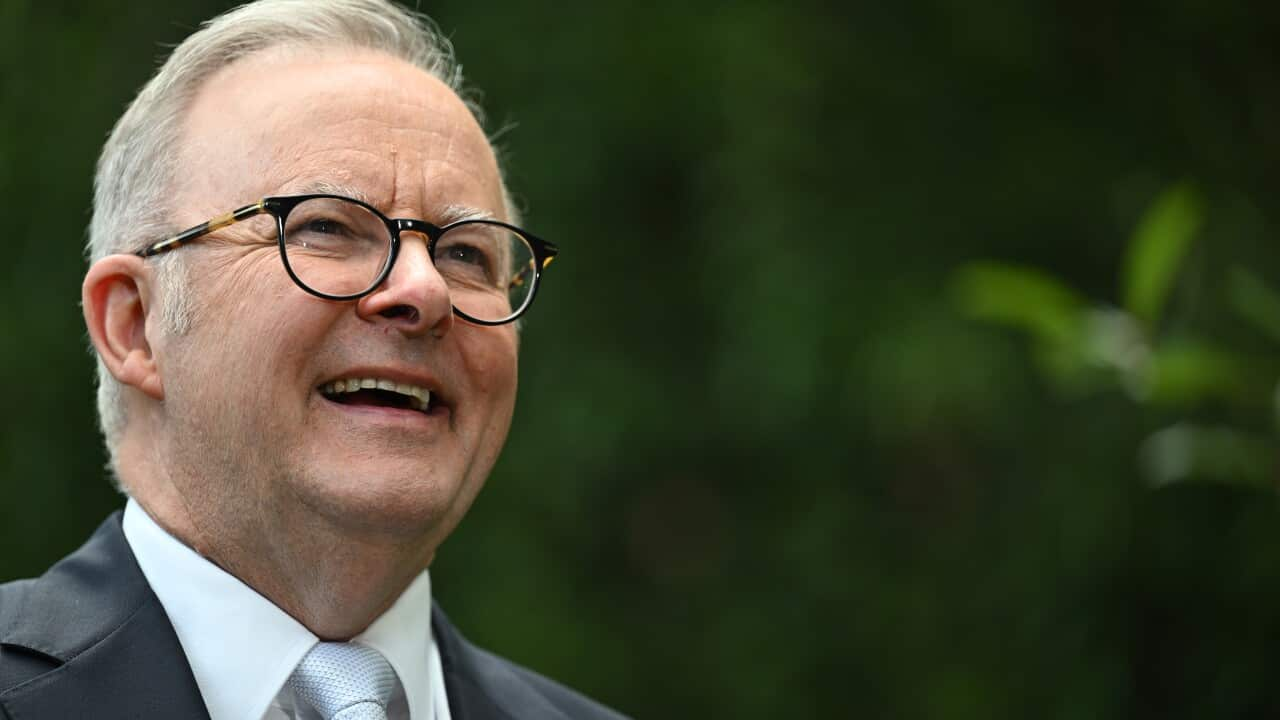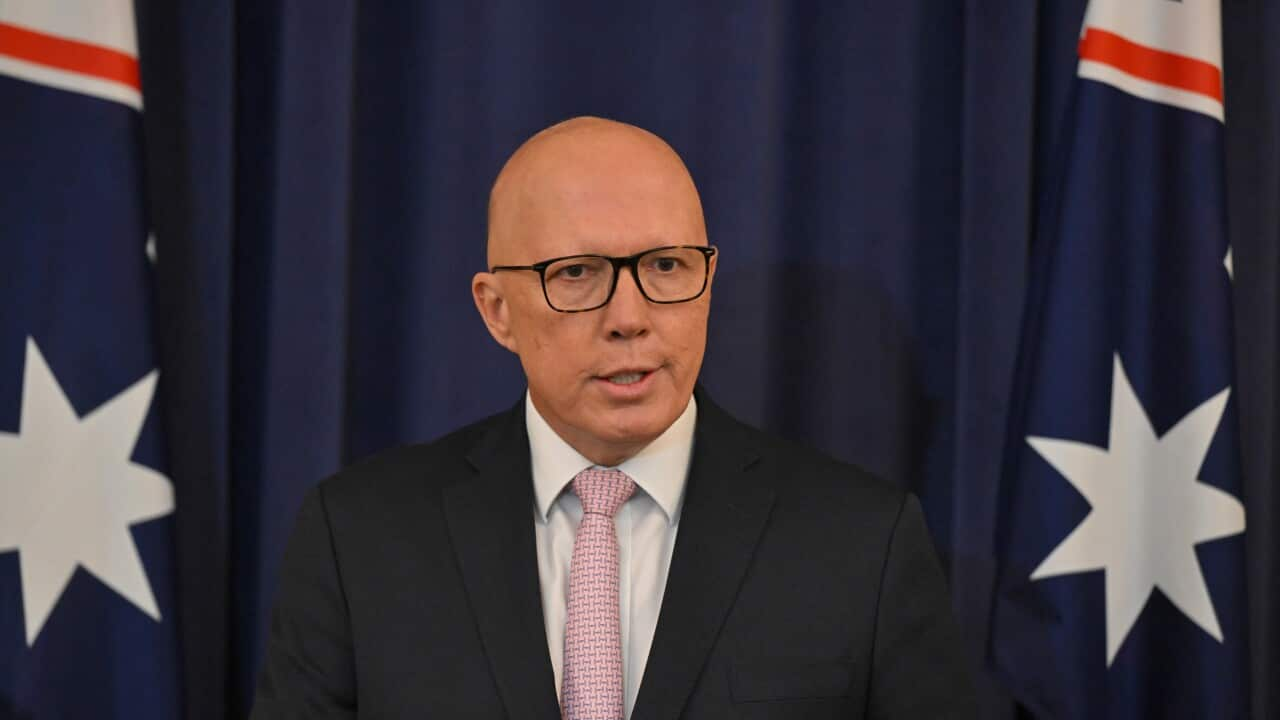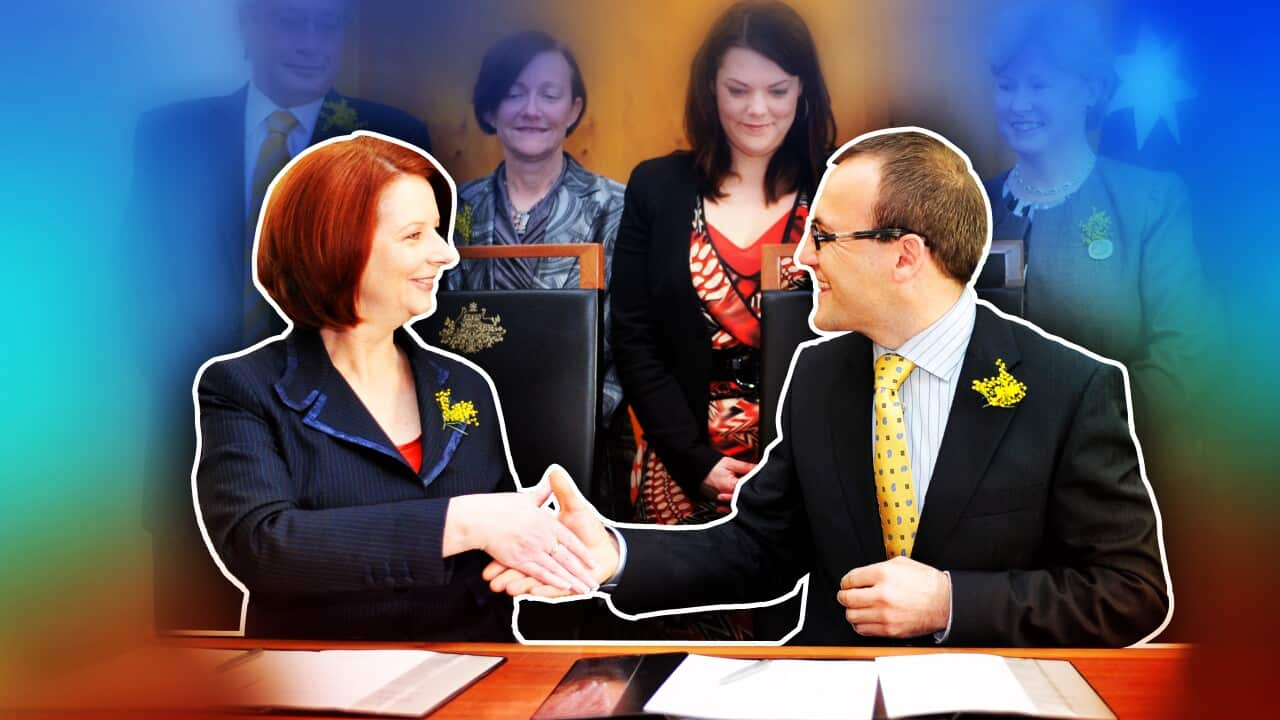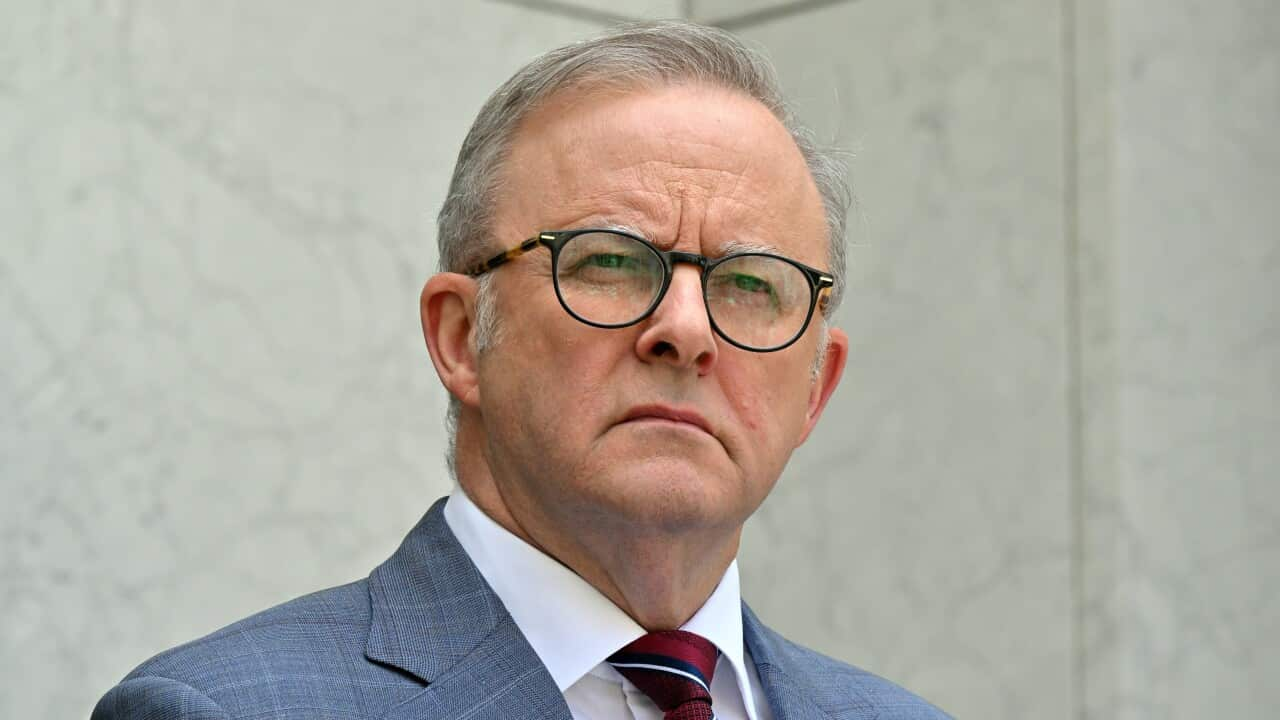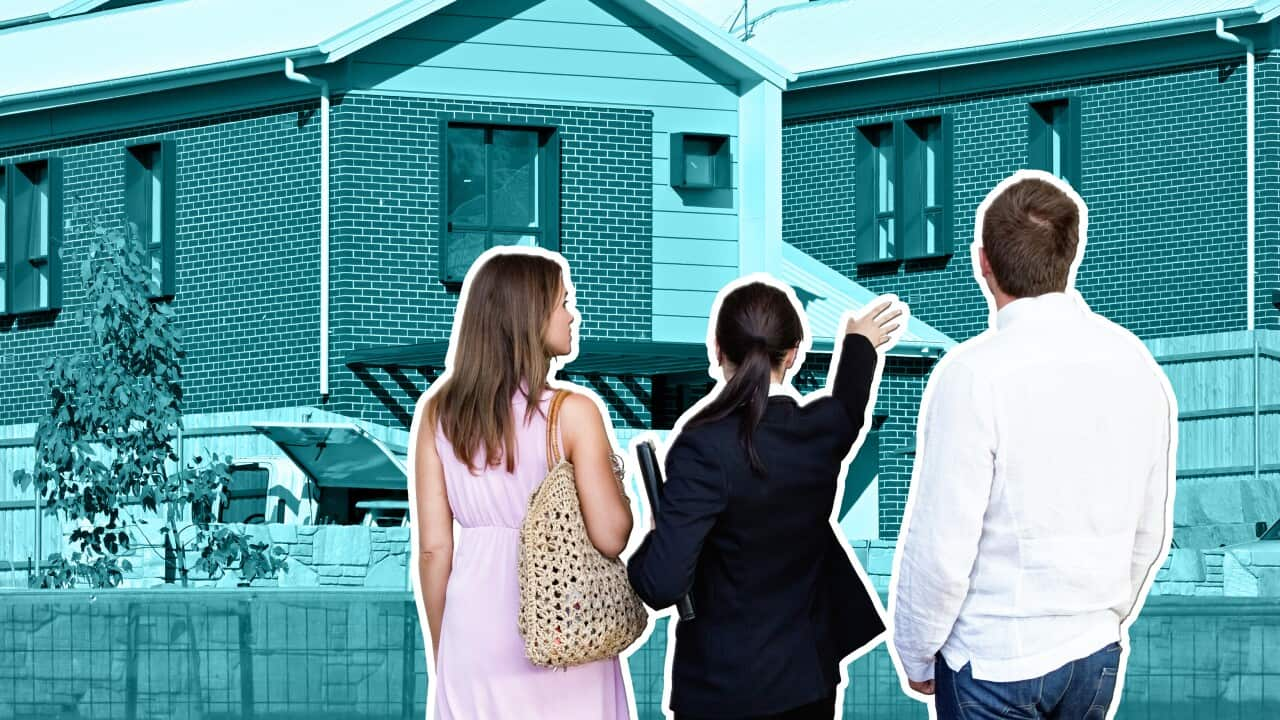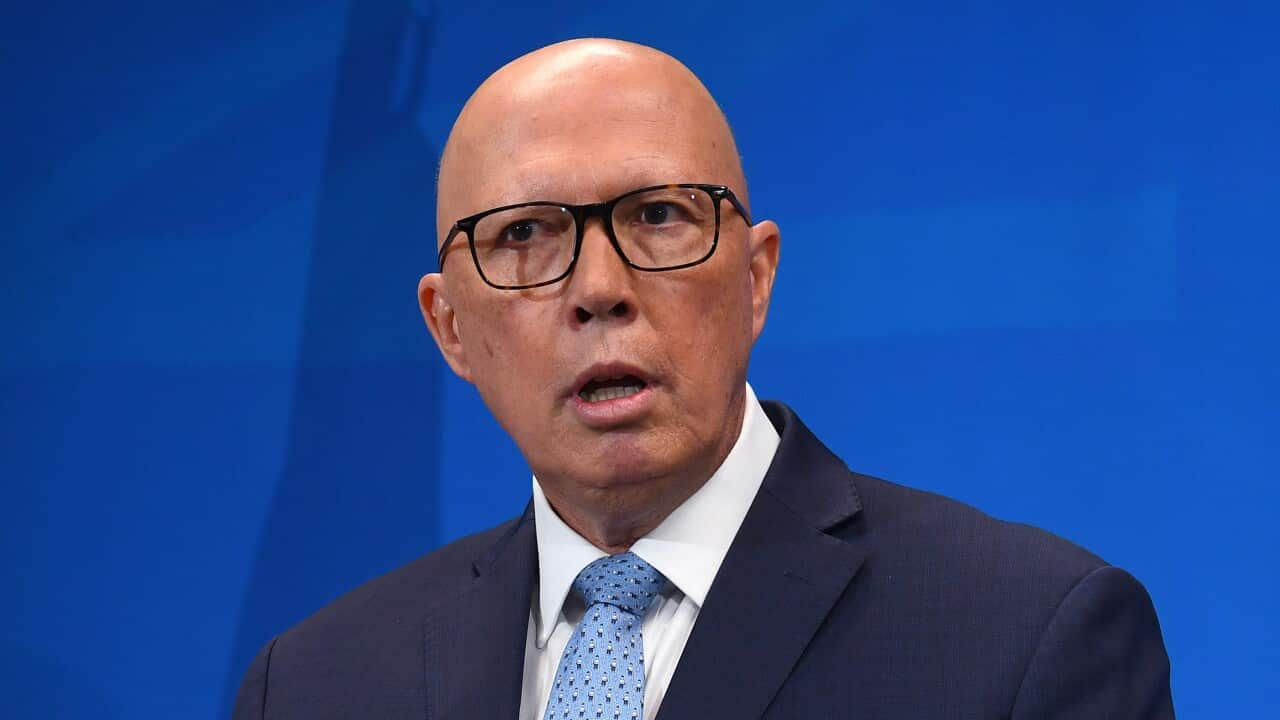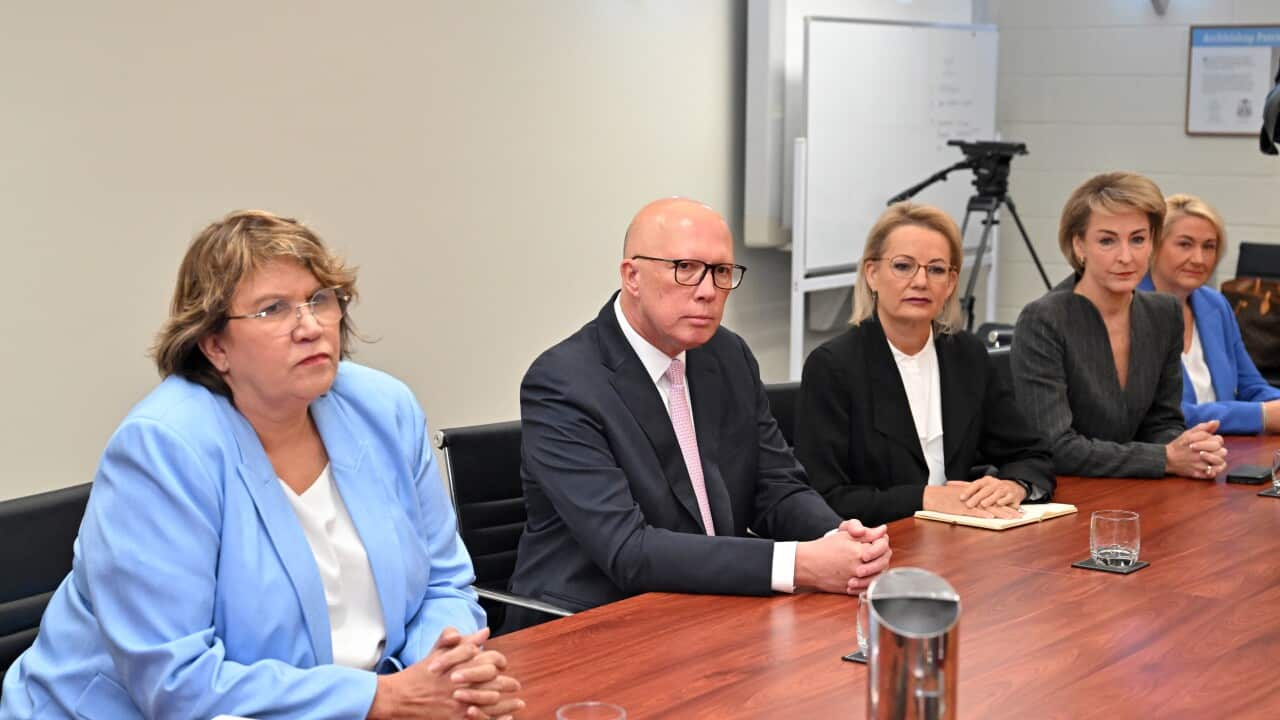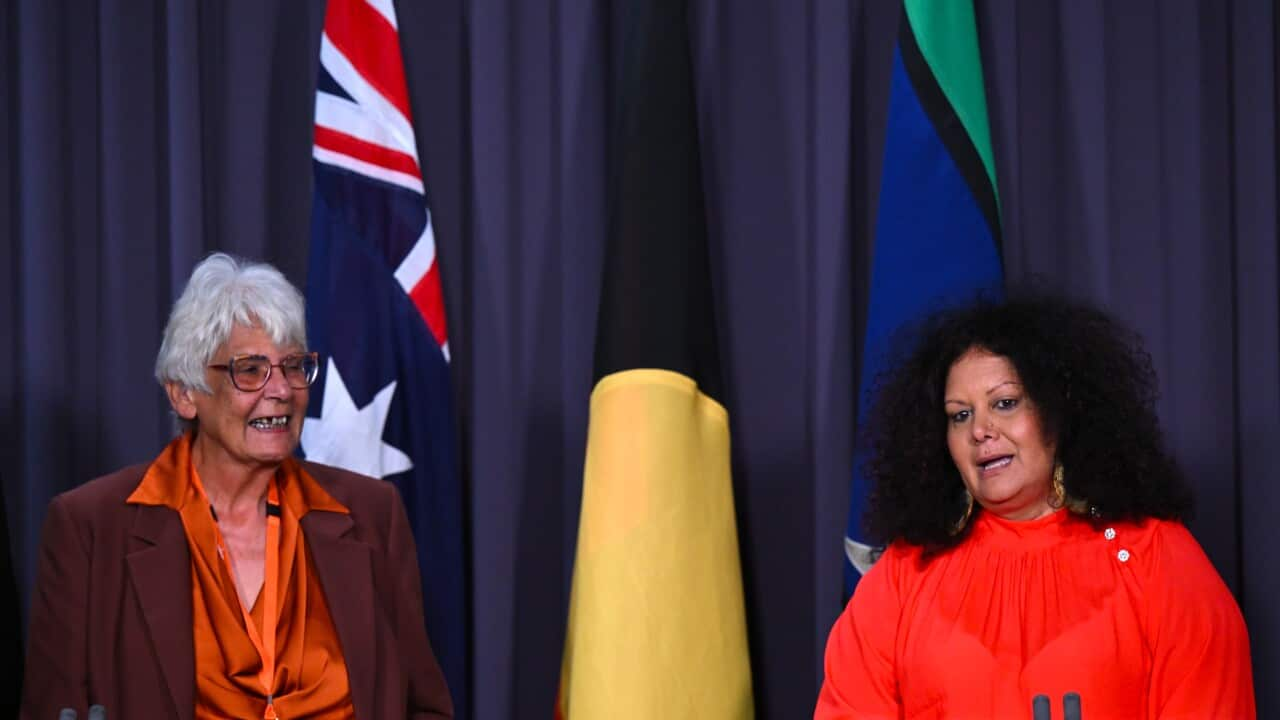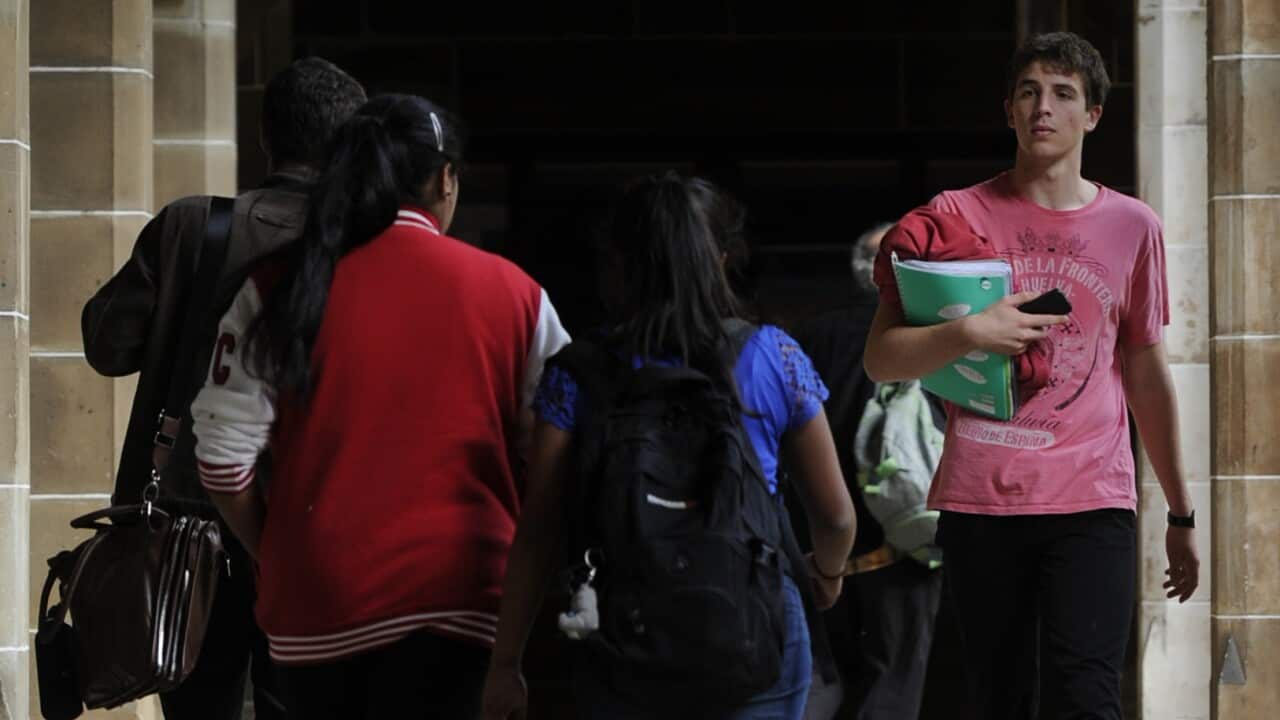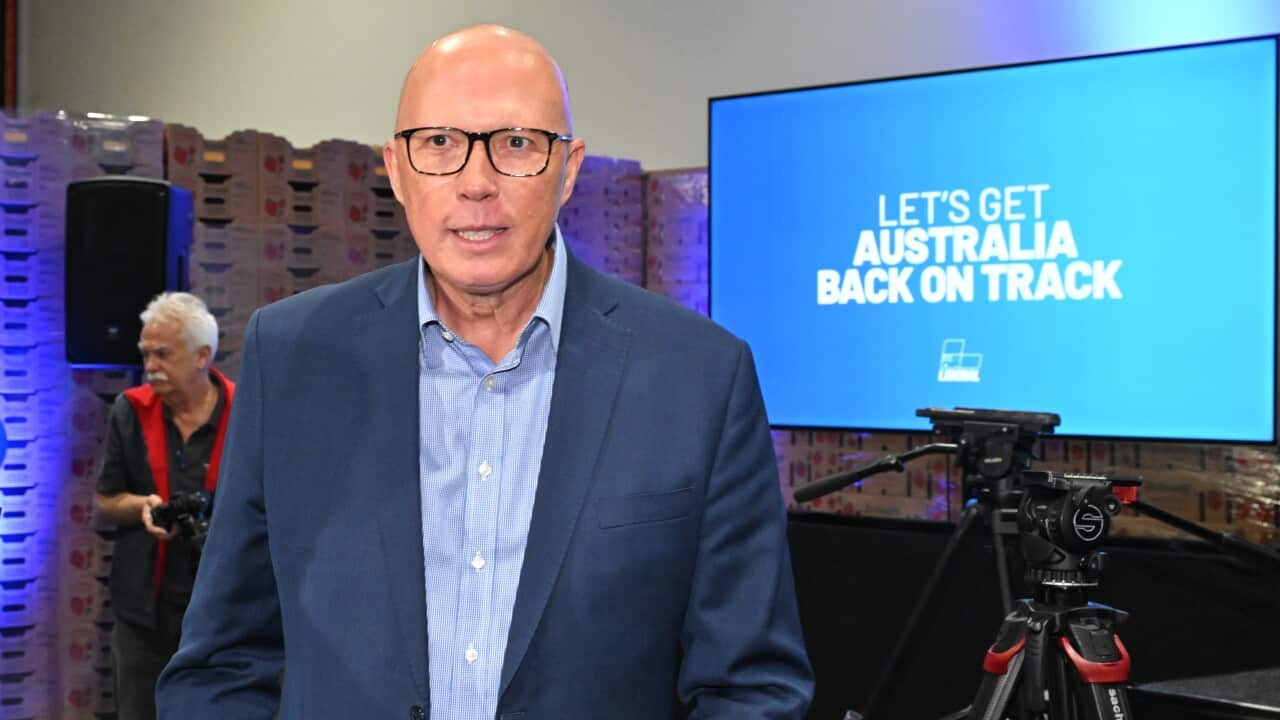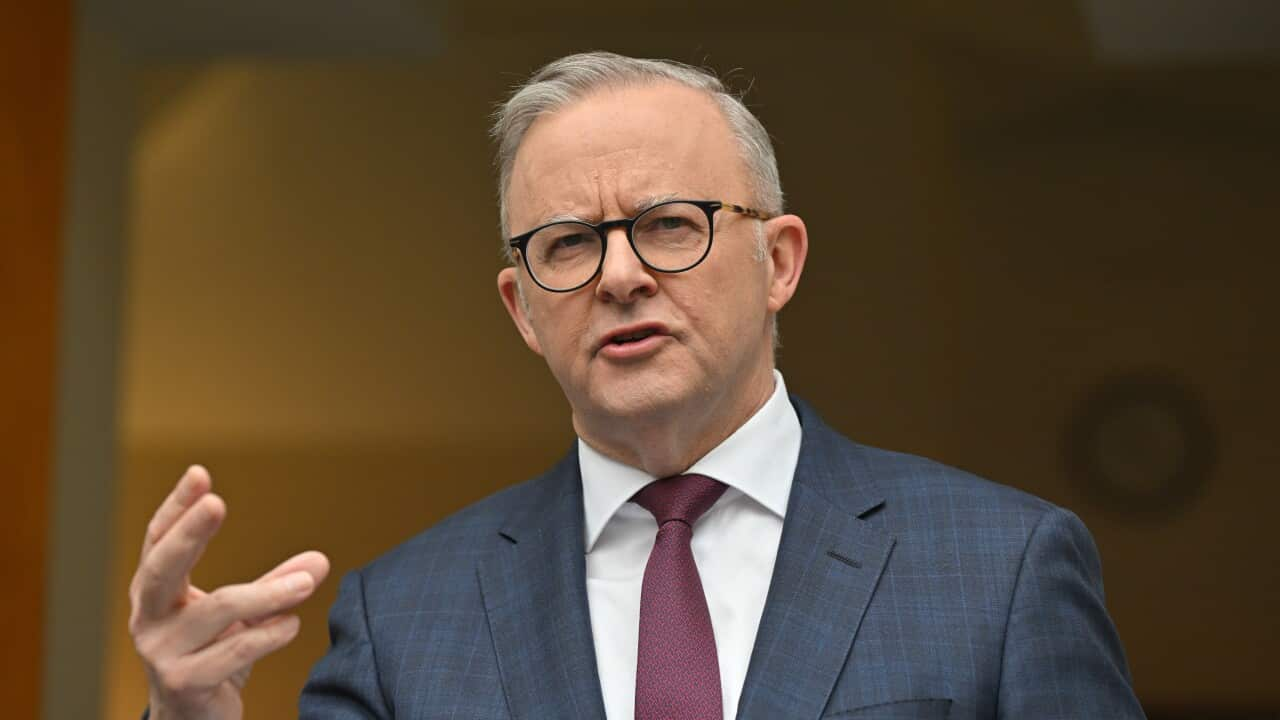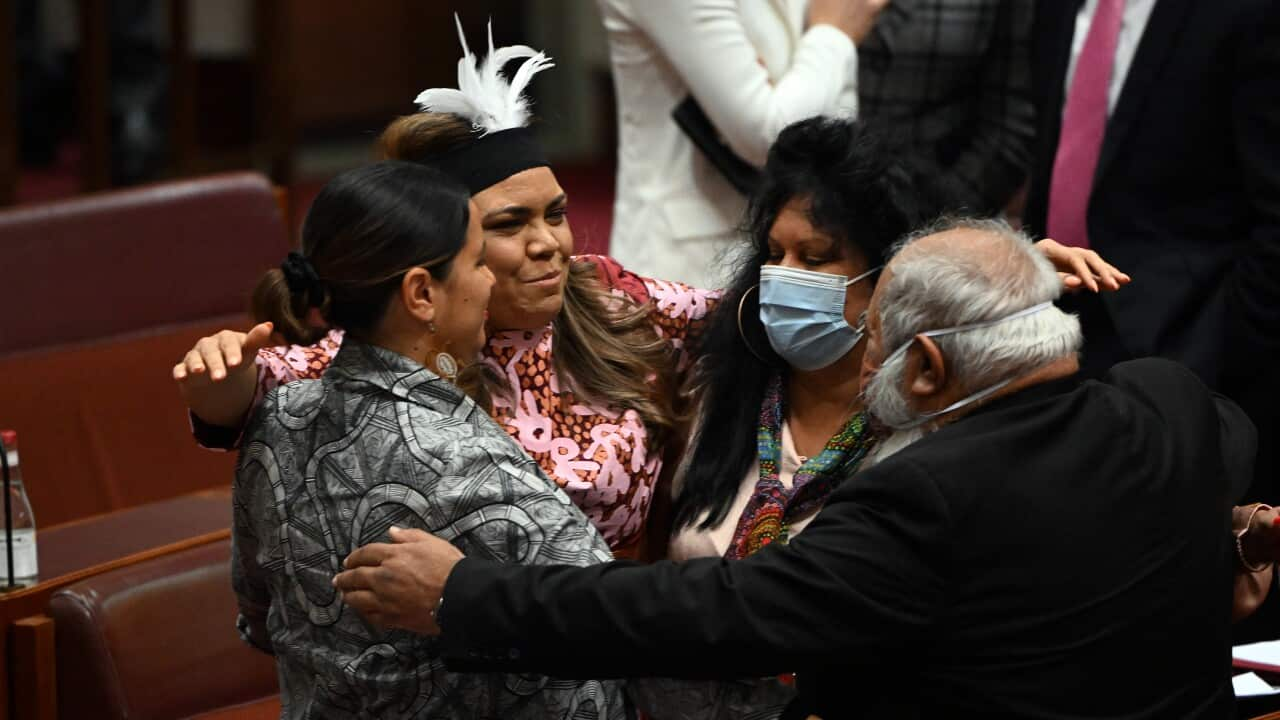Anthony Albanese has announced Australians will head to the polls on 3 May, kicking off a five-week campaign against Peter Dutton for the nation's top job.
With the cost of living crisis at the front of the minds of many Australians and the effects of the Reserve Bank's first interest rate cut in years yet to be fully felt, both major parties are entering the election campaign promoting policies they argue will alleviate financial strain without exacerbating inflation.
In the lead-up to the vote, here are all your questions answered.
When is the federal election?
Prime Minister Anthony Albanese has officially announced the date Australians will head to the polls as 3 May.
"Over the last few years, the world has thrown a lot at Australia," he said in a press conference outside Parliament House on Friday, 28 March.
"In uncertain times, we cannot decide the challenges that we face, but we can determine how we respond.
"Now on 3 May, you choose the way forward."
Parliament was dissolved on the same day and the government is now in caretaker mode.
How often do we hold elections?
Every three years, the Australian prime minister will call a federal election.
Because there are no fixed terms or election dates, forecasting when this will happen is a guessing game.
Generally, the prime minister will call an election at a time that's politically advantageous for them.
Elections are held on Saturdays, and candidates need to be given at least 33 days' notice of the poll.
How is a federal election called?
When the prime minister decides to call an election, a few steps need to happen.
First, the prime minister needs to tell the representative of the King, the governor-general, that they wish to call an election.
Then, the governor-general terminates the sitting parliament and dissolves the House of Representatives.
Afterwards, the governor-general instructs the independent electoral body, the Australian Electoral Commission (AEC), to conduct an election, which includes setting dates for nominations, electoral rolls, and, of course, election day.
Then, the writs are issued.

Voting is compulsory in Australia, and to cast your vote, you must be registered on the electoral roll. Source: AAP
What are the key election dates?
The federal election will take place on 3 May, with polling booths open from 8am to 6pm. Voting locations are typically set up at local schools, church halls, or community centres.
Voting is mandatory for all Australian citizens aged 18 and over.
Writs will be issued within 10 days of the parliament's dissolution, which took place on 28 March. Enrolment closes seven days after the writs are issued.
How can I enrol to vote?
To enrol to vote, you need to be 18 or older. If you've moved since 2022, remember to update your address as well.
Alternatively, you can enrol in person at your local AEC office or submit an .
The AEC website also provides that may make enrolling more challenging.
How do I know if I'm registered to vote?
Voting is compulsory in Australia. To vote, you must be registered on the electoral roll. . If you're not enrolled, there's still time to do so.
The electoral roll will close seven days after the issue of writs, which must happen within 10 days of the parliament's dissolution.
Which electorate am I in?
When and where should I be voting?
Typically, a majority of Australians will head to a local polling place on election day (3 May) to cast their votes.
However, this is not a requirement, as if you're unable to vote on election day itself, you're welcome to vote in person in the two weeks leading up to the election or via a postal vote.
In fact, in the last federal election in 2022, half of the voters decided to cast their ballots like this,
You can find your local polling place on the AEC website.
How can I vote if I'm away on election day?
If you are not able to head to a polling place in your electorate — for example, if you are travelling or working — on 3 May, you still need to vote.
Early voting centres will open across the country progressively from Tuesday, 22 April. Locations and addresses will become available closer to the early voting period.
You may also be eligible to apply for a postal vote, which means your ballot papers will be sent to you in the mail. You can apply for a postal vote now .

There are a number of options for early voting ahead of the federal election. Source: AAP / Bianca De Marchi
The AEC also offers mobile voting in some locations to cater for people who cannot attend an in-person polling place. This can include people in residential aged care, hospitals, mental health facilities, prisons, homelessness services, and First Nations communities. Mobile voting schedules for the 2025 federal election have not yet been finalised.
What to know about Anthony Albanese, prime minister and Labor leader
As Prime Minister Anthony Albanese makes his case for a second term in office, here's everything you need to know about his life and political career.
Five quick facts about Anthony Albanese
1. He became prime minister in May 2022, as Australia started to emerge from the COVID-19 pandemic, ending almost a decade of Coalition government.
2. Before securing the top job, he had been in parliament for over a quarter of a century, mostly as a member for the inner-western Sydney seat of Grayndler.
3. Known widely as "Albo", the 61-year-old father-of-one has traditionally aligned himself with Labor's left; however, as prime minister, he has adopted more centrist positions, analysts say.
4. He joined the Labor Party at age 16 and says his working-class roots have shaped his political values.
5. When taking office, Albanese said his government's areas of focus would be the cost of living, bolstering Indigenous rights, and tougher climate action.

Prime Minister Anthony Albanese has said Australians will go to the polls on 3 May. Source: AAP / Mick Tsikas
What have been some of Anthony Albanese's most challenging moments as PM?
Since taking office, Albanese has had to navigate a complex mix of domestic and international issues — including a cost of living crisis, a worldwide inflation surge, and the wars in Ukraine and Gaza.
Early in his term, one of his most defining policies was to hold a referendum on whether or not to in Australia's constitution.
After a divisive campaign, . The result devastated many Indigenous Australians and hurt Albanese politically, some analysts argue.
Legislative setbacks, rising interest rates and living costs, as well as concerns over housing affordability, have impacted Albanese's government, while Labor says it has given cost of living relief through tax cuts, energy bill relief and an increase to paid parental leave.
What to know about Peter Dutton, the leader of the Opposition vying to be PM
Peter Dutton is seeking to defy almost 100 years of political history by defeating Prime Minister Anthony Albanese and unseating his first-term government. Here's a rundown of his life and career.

Peter Dutton became the Liberal leader in 2022.
Five quick facts about Peter Dutton
1. He has served as the leader of the Liberal Party since 2022 after it suffered its worst electoral loss since its formation in 1948.
2. He has represented the Queensland seat of Dickson in the Australian House of Representatives since 2001.
3. The 54-year-old has held several significant positions in successive Coalition governments, including stints as the Minister for Home Affairs, Health and Defence.
4. A married father of three, Dutton was a police officer and businessman before entering politics.
5. He is known for his conservative views on issues such as national security, immigration, and law and order.
What did Peter Dutton do before he entered politics?
Before his time in Canberra, Dutton was a small business owner who also had a long career in law enforcement.
In 1988, he joined the Queensland Police Force (now Service) where he worked as an officer for several years before becoming a detective. He later studied at the Australian Federal Police College, and held positions in the National Crime Authority and Drug and Sex Offenders' Squads. He often credits his background in policing as playing a critical role in shaping his views on issues such as security and immigration.
What to know about Adam Bandt, the leader of the Australian Greens
Adam Bandt has framed the upcoming election as a choice between progressive policies that make people's lives better, or a US-style shift to the right.

Adam Bandt has been leader of the Australian Greens since 2020. Source: SBS News
Five quick facts about Adam Bandt
1. Bandt has been the leader of the Australian Greens since 2020 and a member of parliament since 2010.
2. He was the first Greens candidate to win a seat in a general election for the House of Representatives.
3. The 52-year-old has framed the upcoming election as an opportunity for the Greens to win "new seats across the country" and potentially play a pivotal role in a minority government.
4. During his time at university, he was a member of the Left Alliance, a national organisation of socialist, feminist, and progressive students.
5. Under his leadership, the Greens have come up with what they refer to as a series of "Robin Hood-style" policies to take to the election, which would tax the super-rich to free up money for the cost of living issues.
What did Adam Bandt do before he entered politics?
Bandt was born in Adelaide but spent most of his childhood in Perth. After working with a string of student unions both before and after earning his degree in Law and Arts at Murdoch University, .
He eventually became a partner at the firm Slater & Gordon, where he specialised in industrial law and represented several unions. After going part-time in 2008, he completed a PhD at Monash University.
What to know about David Littleproud, leader of the National Party
If Peter Dutton becomes Australia's next prime minister, David Littleproud would be in the running to become his deputy. Here's a basic rundown of the National Party leader's life and career.

David Littleproud was elected to lead the National Party in May 2022.
Five quick facts about David Littleproud
1. He was elected to lead the National Party in May 2022, after Labor's win, succeeding Barnaby Joyce.
2. He has represented the Queensland seat of Maranoa in the House of Representatives since 2016.
3. Throughout his career, Littleproud has been an advocate for regional Australian communities, often stressing the importance of agriculture and calling for more infrastructure development.
4. A father of three, Littleproud worked as a farm manager and businessman before he became an elected official.
5. He was born and raised in the rural town of Chinchilla in Queensland's Western Downs Region.
What did David Littleproud do before he entered politics?
Before entering office in 2016, Littleproud worked as an agribusiness banker with the National Australia Bank (NAB) and Suncorp, where he focused on rural and agricultural finance.
He lived and worked in several rural towns, including Miles, Nanango, Charleville, St George, Stanthorpe and Warwick.
Australia's oldest political party: A guide to Labor ahead of the 2025 election
The Australian Labor Party — or ALP — is Australia's oldest political party.
The ALP is synonymous with Australia's labour and union movement, being born from the "great shearer strikes in western Queensland in the 1890s", according to Wayne Swan, former treasurer and the party's current national president.
Back then, working conditions were tough, so trade unions, which are organised groups of workers, were formed.
They wanted their demands taken seriously by the government, so they formed the Labor Party in 1901.
At the start, Labor's policies were focused on workers' rights. It campaigned for the eight-hour working day and created the minimum working wage.
In its early days, it was a strong advocate for the ‘White Australia Policy’ and was largely against immigration.
But these days, the party's priorities have shifted.
What does the ALP look like now?
Labor fills the space of the more progressive party out of the two main contenders, and is considered centre-left.
Senior lecturer at the Australian National University's School of Politics and International Relations, Jill Sheppard, says the party is rooted in unions.
"Sometimes, when we think we'd expect Labor to be a bit more progressive on some issues, or maybe a bit more pro-immigration, we can sometimes explain that by drawing on their history of being really trade union representatives," she tells SBS News.
The Labor Party says it also represents the working class and workers' rights in Australia, rooted in strong union ties.
"We are a party that is proudly of the union movement and associated with the union, so the union movement is a participant in our party," Swan told SBS News. "Not all union members are members of the Labor Party, but many are.
"The ethos of unionism, the solidarity that comes from it, looking after your mate, if you like, always been having an eye out for those that are more vulnerable, and lending them a helping hand lies at the very core of unionism, but also at the very core ethos of the Labor Party."
At its core, the Labor Party believes the government has a role in "spreading" opportunity, according to Swan.
He says it's what you'd call a party of big government.
"We fundamentally believe that government has got a role to play in creating prosperity and then spreading the opportunity," he said.
"So we see a significant role for government intervention in the economy, in clear contrast to the number of conservative parties over the past 100 years that have argued for essentially a survival of the fittest mentality on their side of politics, small government, regressive tax, a very sparse social safety net."
What have been the Labor Party's biggest achievements?
Sheppard says over the last 15 years, the party would be proud of its social achievements.
"We might look at things like the apology to the Stolen Generations, we might look at constant minimum wage increases, things that don't always sound very exciting, but they are the important business of governing the country, making sure that there is a safety net for the worst off Australians," she said.
Some of its biggest achievements include:
- Introducing universal healthcare in 1974 (first known as Medibank, now Medicare)
- The Native Title Act of 1993
- Setting up the National Disability Insurance Scheme, the NDIS, in 2013
What's ahead for the Labor Party this election?
As we head into the election, Swan says it's not going to be easy for Labor.
"There's a myriad of challenges," Swan said. "There's been no government in the last couple of years that's been re-elected internationally in this cost of living crisis, which is largely internationally induced. So it's a tough environment to go to the people."
This election, Labor's policies include:
- Cutting student debt
- Making childcare cheaper
- Improving Medicare
- Investing in renewable energy
So how does the party stack up to its original manifesto? Sheppard says there's been a lot of change.
"The Labor Party of today is obviously very different to 150 years ago," she said. "What that means for them now is that they are expected to both represent workers and represent people who want, you know, a progressive, sort of socially liberal, multicultural Australia."
Australia's most election-winning party: Liberal Party — then and now
Formed in 1944, the Liberal Party was born in response to the Labor Party.
Dr Jill Sheppard, senior lecturer at The Australian National University's School of Politics and International Relations, said there was a simple idea behind it.
"The Liberal Party really just formed in response to the Labor Party, and that has shaped not only sort of their history, but it also shapes where they are at the moment," she told SBS News.
Robert Menzies, the founding member of the Liberal Party, was very strong on the idea of individual choice.
His assessment was that the Labor Party had been born out of the union movement and that no-one spoke for people who were self-employed and the middle class.
A bunch of other people thought the same thing, so they banded together to form the Liberal Party, as former Liberal Party frontbencher George Brandis explains.
"The Liberal Party was conceived to represent the broad mainstream of Australia in those days, not organised labour, and it certainly wasn't designed to represent the big end of town either," he told SBS News.
In 1949, the Liberal Party won its first election, partnering up with the Country Party of Australia, making Robert Menzies prime minister.
"He [Robert Menzies] was hugely successful at creating and sort of driving this sense of purpose that represented an Australian society that made sense to a lot of people, and he called these he's forgotten people," Brandis said.
For this reason, the Liberal Party focused on people who were middle-class, owned small businesses, and professionals.
"Menzies said the rich can look after themselves; the working man is often looked after by his trade union," Brandis said.
"But middle-class people, small business people, professional people, farmers, artisans, those sorts of people have no-one to look after them. So that was the original base of the Liberal Party."
Menzies was a strong advocate of the 1901 Immigration Restriction Act — more commonly known as the 'White Australia Policy'.
But in 1966, the Liberal Party changed laws, paving the way to abolish the policy.
Wait, doesn't liberal mean left?
The Liberal Party is considered to be the more conservative of the two major parties, leaning right.
And since the party is more politically conservative than liberal, the name might seem a bit confusing.
While in other parts of the world, parties that oppose labour are often called conservative, Brandis said that was not the original intent of the party.
"Of the various options that Menzies had in choosing the name of his new party, he avoided calling it the Conservative Party, because he wasn't a conservative, he was a classical liberal," he said.
But Sheppard said there is a conservative element.
"There are two core streams of the Liberal Party, and one is what we would call liberal, but we often call that small liberal. What we mean is there is a genuine belief that the government is not here to help you, that you are your best advocate, that you should you can best decide how to live your life, and the less the government does, the better," she said.
"The conservative stream of the Liberal Party does think that government is okay. They're much less resistant to the idea that government can solve our problems."
What does the Liberal Party look like nowadays?
Nowadays, the Liberal Party traditionally seeks a "smaller, quieter Australia", Sheppard said.
"But what they are less happy about are things like same-sex marriage, open borders, you know, international students. They want a smaller, quieter Australia that looks more like it did in the 1960s," she said.
"It's an incredibly different set of principles that the Liberal Party is trying to manage. Under Peter Dutton, the party feels quite conservative. It feels like a party that just wants us to live quietly, does not want to rock the boat too much."
The Liberal Party teams up with the Nationals in a coalition to form a government.
Brandis describes it as a "functional" and "necessary" relationship.
"The National Party, though, is a very different beast from the Liberal Party," he said.
What have been the Liberal Party's biggest achievements?
Sheppard said the party would be proud of its economic achievements.
"Liberalisation of the economy, you know, the ability for anyone in the middle class or working class to move up in society, to own their own business, to go to university if they wish, to live the kind of life that they choose that isn't tied to their occupation or to what their parents did," she explains.
"They would say that is their core achievement over the last 30 years."
Some of the most well-known Liberal Party policies include:
- Resettling Vietnamese refugees after the Vietnam War in 1976.
- Establishing the Special Broadcasting Service in 1978.
- Bringing in tougher gun laws after the Port Arthur massacre in 1996.
- And creating Operation Sovereign Borders in 2013.
What's ahead for the Liberal Party in this election?
For this year's election, the Liberal Party's slogan is 'Get Australia Back on Track'.
Their policies include:
- Building Australia's first nuclear reactors
- Being tough on crime
- Reducing wasteful spending, including cutting public service jobs
- Reducing migration
So, how does the party stack up to its original manifesto? Pretty well, Sheppard said.
"Weirdly, I think the Liberal Party is probably closer to its original party than the Labor Party is.
"Even though they've never had a strong sense of purpose necessarily, apart from opposing Labor, there's always been tension between conservatives and liberals inside the Liberal Party. That was the case in 1944 when the party was founded and it's the case today."
The Greens could hold the balance of power in parliament. So what do they stand for?
In just three decades, the Greens have transformed from what was essentially an environmental protest movement to Australia's third-largest party by vote.
At the 2022 election, the federal Australian Greens secured 12.2 per cent of the primary vote — an almost 2 per cent increase from the party's primary vote in 2019.
The Greens are looking to achieve even greater success on , capitalising on the bloc of generally more progressive who outnumber baby boomers for the first time this election.
As thousands flock to pre-polling centres, says the party is feeling confident.
"We're getting a terrific response on the doors, the streets and the polling booths to our plan to get dental and mental health into Medicare, finally tackle the housing and rental crisis, make child care free, and stop opening up new coal and gas mines in the middle of a climate crisis," the member for Melbourne says.
What are the Greens' main policies?
Rodney Smith, a professor of Australian politics from the University of Sydney, says the Greens have been able to position themselves quite successfully as an alternative for disenchanted Labor voters who are looking for a more solid, leftist, or progressive policy package.
Key promises from the Greens include:
- Cancelling all student HECS debt.
- Expanding Medicare to cover dental.
- Banning new coal and gas projects.
- Introducing higher taxes on billionaires and big corporations.
On the campaign trail, the party has also pledged to make HIV prevention medications PrEP and PEP free — , in a headline-grabbing move by Brisbane MP Stephen Bates.
They've also unveiled a national plan to provide free school meals.
But Greens MP Max Chandler-Mather, the party's housing and homelessness spokesperson, says housing is the "defining issue" of the election.
The party has put forward its own measures to tackle the housing crisis, including discounted mortgage rates and capping rents.
It will also scrap for investors with more than one property.
"There's certainly a lot of people voting Greens for the first time in their lives because we're the only party with policies to make housing affordable," Mather says.
with the major parties' handling of international issues, particularly the conflict in Gaza.
How powerful are the Greens?
The Greens have taken a firm stance, pledging to continue calling for an end to the occupation of Palestinian territories and urging Israel to halt what they describe as an ongoing genocide in Gaza,
Jill Sheppard, a professor of Australian politics at the Australian National University, says the Greens' popularity in the Senate is particularly important.
As the Greens can't form government on their own, their policies are more an indication of how party members may vote on legislation, she says, and the number of seats they secure will determine how much power they'll wield over legislation in the upper house.
"Although we focus on the House of Representatives, particularly around an election because that's where government is won and lost, the Senate is still really important for passing legislation after the election," Sheppard says.
"There, the Greens have held the balance of power for quite a while. They are very experienced Senate negotiators, and so even if they are sidelined in some kind of independent Labor minority government, they will still be strong in the upper house."
Polls suggest the Greens are likely to retain the five Senate seats they are contesting in this election, meaning it's likely the party will retain its powerful 11-seat upper house voting bloc.
In the House of Representatives, Prime Minister Anthony Albanese has insisted he won't do a deal with the Greens to form government if Labor fails to win a majority.
The Coalition has frequently raised the prospect of a Labor-Greens alliance as a point of concern for voters, pointing out that the Greens and Labor usually recommend that voters put the other party in the second position on how-to-vote cards.
Sheppard says that, if Labor falls short of the 76 seats it needs for a majority, it will likely first look to independents to form government.
"They probably feel like they can work with [Independents] more easily ... without offering the Greens a spot in cabinet, which would be about the worst-case scenario for the ALP," Sheppard says.
"The major parties want you to think that a hung parliament is bad because they desperately want majority government for themselves. But a hung parliament isn't bad.
"We saw between 2010 and 2013 a minority government last the full term quite successfully."
Bandt has said that in the event of a hung parliament.
The Greens' relationship with Labor
The relationship between the Greens and Labor has also been fraught with tension, with both parties fighting to capture votes on the left side of politics.
"At the national level, the relationship between the Greens and Labor has never been a particularly happy one," Smith says.
"Initially, it was because there was a tension between Labor's union base and many of the environmental concerns and policies of the Greens.
"More recently, it's had to do with that trend of left voters moving their support away from the Labor Party to the Greens, and the Greens using their position to pressure Labor to shift its legislative agenda in a more progressive direction."
'They didn't see us coming'
The Greens are defending their record number of lower house seats, three of which turned Green for the first time at the last election, shocking both major parties.
All three were inner-city Brisbane electorates. Griffith was won from Labor, while Brisbane and Ryan flipped from the Liberal National Party.
Ryan, once considered a rock-solid Liberal seat, is now a key battleground the Coalition is determined to reclaim.
"The LNP thinks they own that seat. I ousted them in 2022. They didn't see us coming then. They are certainly seeing us coming now,” Greens member for Ryan Elizabeth Watson-Brown says.
Watson-Brown says she's faced verbal abuse and her signs have been vandalised throughout her campaign.
She blamed far-right groups who "want to oust [her] from the seat" and said she's also concerned about the that's being spread about her.
What are Labor's key policies?
Labor has pledged tax cuts if they win the election, with the average earner getting $268 back in their pocket by 2026, according to the treasurer.
Earnings between $18,201 and $45,000 are currently taxed at 16 per cent, and this will fall to 15 per cent in 2026-27 and 14 per cent in 2027-28, Labor said.
The party has also pledged to increase access to childcare and a $1 billion fund for 160 new childcare centres.
Labor also said they would spend $8.5 billion on increasing bulk-billing rates at GPs, and an extension of the energy rebate until the end of 2025 which will save households $150.
The Coalition has agreed to both of these policies.
What are the Coalition's key policies?
The Coalition said there would be no promise of income tax cuts, but that fuel excise would be cut in half from July.
This would mean savings of 25 cents per litre, Opposition leader Peter Dutton said.
People would be allowed to use more of their superannuation towards a house deposit, and the Coalition said it would invest $5 billion into essential infrastructure to "unlock up to 500,000 new homes".
The party would restore the number of mental health sessions subsidised by Medicare from 10 to 20.
It said it would allow businesses with a turnover of less than $10 million a year to claim a tax deduction of up to $20,000 for business-related meal and entertainment expenses and increase the instant asset write-off for small and medium businesses from $20,000 to $30,000.
Major election promises from Labor, the Coalition and the Greens
Prime Minister Anthony Albanese and Opposition leader Peter Dutton have spent the last few weeks pledging billions of dollars in commitments as they try to sell voters their vision for Australia's future.
Here's an overview of the major national pledges so far. Scroll down as we've covered topics including Health, Small Business and Industrial Relations, Housing, the Cost of Living, Defence, Indigenous Affairs, Young People, Energy, and Migration.
Health
Labor
Labor hopes to incentivise more doctors to bulk bill patients as part of an which also includes $400 million to train more nurses and doctors.
The government will also open an — on top of the 87 already operating — by June 2026, at a cost of $644 million.
Women suffering from endometriosis, pelvic pain or menopause will have access to more specialised clinics as well as cheaper medicines, with Labor pledging a $573 million boost to women's health.
The government has promised to cap the cost of most prescriptions to $25 (currently $31.60) — and $7.70 for concession card holders — by January 2026.
Labor will also expand access to free mental health support as part of a $1 billion investment in mental health services.
Coalition
The Coalition has matched Labor's Medicare promise, with a $9 billion commitment including $400 million in financial incentives for junior doctors who enter general practice.
Dutton has also pledged $400 million towards youth mental health.
The Coalition has also promised to go ahead with cuts to the price of medicines on the PBS as well as boost funding to women's health care.
Greens
The Greens want to expand Medicare to include dental care and mental health.
Small businesses and industrial relations
Coalition
The Coalition has pledged to make the small business instant asset write-off a permanent tax deduction, boosting it to $30,000 for businesses with a turnover of up to $10 million.
Dutton also wants to increase the number of small businesses in Australia by 350,000 over four years by offering tax incentives that encourage reinvestment.
Under the entrepreneurship accelerator scheme, businesses would pay tax on 75 per cent of their first $100,000 of taxable income, and on 50 per cent of the second $100,000. The ratio of tax paid will increase in the subsequent two years of operation.
Small and medium-sized businesses will also be able to claim up to $20,000 in staff meals each year.
Labor
Labor has vowed to and said it would enshrine them into law if it is re-elected.
It will also ban non-compete clauses, enabling workers earning under $175,000 to more easily switch jobs to a competing employer or to start a competing business.
In March, the government legislated an extension to the $20,000 instant asset write-off for small businesses but has not committed to making it permanent.
LISTEN TO

Climate Wars (Revisited): Party Time Ep 3
SBS News
26:41
Housing
Both major parties have their sights set on making housing more affordable, although
Labor
Labor will expand its 5 per cent deposit scheme so that every first home buyer is eligible. The government will act as a guarantor for buyers to purchase with a smaller deposit (instead of the usual 20 per cent) saving them from having to pay lenders' mortgage insurance. There will be no income limits or caps on places.
It will also build 100,000 new affordable homes exclusively for first home buyers, with construction to start in 2026/27.
More first home buyers will be able to access the , which allows them to buy with a deposit of 2 per cent if they are willing to give the government a 30-40 per cent stake. Income caps will be increased from $90,000 to $100,000 for individuals, and property caps will also be increased.
In addition to these measures, the government has committed $100 million to refurbish and build more crisis and transitional housing for women leaving domestic violence or at risk of homelessness.
Labor hopes to speed up the construction of homes as part of its existing target to build 1.2 million homes by 2029, pledging $626 million towards apprenticeship incentives for construction workers.
Apprentices in housing construction will receive an extra $10,000 at intervals, with the first payment at six months and the last when they complete their training.
Coalition
For Australians struggling to put together a deposit, a Dutton-led government would allow Australians to access $50,000 of their superannuation to buy a first home.
The Coalition argues this scheme is important for women fleeing violence, who could access their super to buy a home and restart their lives.
It has also pledged $5 billion for building infrastructure such as sewerage and water to support the construction of 500,000 new homes.
First home buyers will also be allowed to claim tax deductions on interest payments against the first $650,000 of their mortgage. The scheme will be available for the first five years for those who purchase a newly built home.
Businesses employing apprentices in areas where there's a skills shortage can get $12,000 a year for the first two years.
Dutton says the housing crisis has been exacerbated by record levels of migration, peaking at 536,000 in 2022-23.
The Coalition has , which will include lowering the permanent migration program by 25 per cent and a 30,000 reduction in the number of foreign students starting higher education each year.
Both major parties support a two-year ban on foreign investors from buying established homes, a policy that came into effect on 1 April 2025.
The Coalition will also scrap the government's $10 billion Housing Australia Future Fund, which aims to deliver 55,000 social and affordable homes over five years.
Greens
The Greens will make housing a priority in the event of a hung parliament, calling for and the 50 per cent capital gains tax (CGT) discount.
Under its proposal, existing investors who negatively gear properties will be allowed to continue doing so, but new investors will only be allowed to negatively gear one property in the future. CGT would be phased out.
The minor party is also pledging to freeze rents for two years, then cap future increases at 2 per cent every two years.
Women's safety
The Albanese government committed $4 billion towards the National Plan to End Violence Against Women and Children with bipartisan support in 2022.
However, victim-survivors and advocates have criticised both major parties for giving the issue minimal attention throughout the election campaign.
Coalition
Domestic violence offenders will appear on a new National Domestic Violence Register if the Coalition is elected, allowing police and relevant agencies to share vital information.
New laws would also crack down on perpetrators using mobile phones and computer networks to cause an intimate partner or family member to fear for their safety.
It includes pledges to increase crisis helpline support and a royal commission into sexual abuse in Indigenous communities.
However, there are no timelines or clear commitments regarding how the $90 million package for women's and family safety will be distributed.
For women fleeing violence and hoping to buy a new home, a Dutton-led government would allow access to $50,000 of their superannuation for a deposit.
Labor
Labor is focusing on financial abuse and violence prevention, with $8.6 million towards initiatives including electronic monitoring and ankle bracelets for high-risk perpetrators.
They will also look at making perpetrators liable for social security debts incurred by a victim-survivor due to coercion or financial abuse and stop perpetrators from receiving their victim's superannuation after death.
Acknowledging the root cause of violent behaviours among men and young boys, intensive behaviour change programs will get a boost under a re-elected Labor government.
Labor has also committed $100 million to refurbish and build more crisis and transitional housing for women leaving domestic violence or at risk of homelessness.
Greens
The Greens' $15 billion package includes a $1 billion annual investment in frontline response services, housing and recovery programs over the next 12 years.
They also seek to double the Escaping Violence Payment to $10,000 to cover expenses such as relocation, bond, food, clothing and medical needs.
Cost of living
Labor
Australian households and businesses will receive anThe money will appear as a credit on people's power bills in two $75 instalments over the last six months of 2025.
In addition, the government legislated two tax cuts for all Australian taxpayers. This means anyone earning more than $45,000 will save $268 in 2026/27 and $536 the year after. The Coalition has vowed to repeal the measure.
Every taxpayer would also be eligible to claim an instant $1,000 tax deduction for work expenses, without needing to fill out paperwork or submit receipts.

The Labor government will deliver two more tax cuts to every Australian taxpayer in 2026 and 2027. Source: SBS News
The government will also make medicines more affordable by capping most PBS prescriptions to $25 by January 2026 and $7.70 for concession card holders.
Coalition
The Coalition has matched Labor's promise for cheaper medicines.
It will also provide a to everyone earning between $48,000 and $104,000 when they lodge their 2025-26 tax return.
Motorists can also expect to save money at the bowser, with a temporary fuel excise cut for the next 12 months.
The $6 billion pledge will result in a fuel excise cut from 50 cents to 25 cents a litre, and is estimated to save a one-car household an average of $14 a week or roughly $700 over one year.
Australians who want to buy a new ute will also benefit from the Coalition's plan to due to take effect on 1 July.
Dutton says he also has an aspiration to tackle bracket creep — so that personal income tax brackets rise regularly in line with measures like inflation — which would mean people keep more of their income. But this would only be looked at after the budget is in order and he has not provided a timeframe for this.

The Coalition will provide a one-off $1,200 tax offset to everyone earning between $48,000 and $104,000 when they lodge their 2025-26 tax return. Source: SBS News
The Greens are pushing for a $29 billion early childhood package, which would give families access to 50 hours of free childcare a week and extend pre-school to 30 hours a week for all three and four-year-olds.
Its policy platform includes capping rental increases and making unlimited rent rises illegal, wiping student debt, and heavily subsidising public transport so that buses, trains, ferries and tram trips only cost 50 cents.
It plans to raise $514 billion to fund these commitments by introducing a 10 per cent tax for 150 of Australia's billionaires, and 40 per cent tax on excess profits for corporations with over $100 million in turnover.
The party has also , which it says would lower housing costs.
Defence
Labor
Labor has vowed to bolster defence spending by , growing it from 2 per cent of GDP to 2.33 per cent by 2033-34.
Both Labor and the Coalition have pledged to seek and return it to Australian hands. It was leased in 2015 to Beijing-controlled Landbridge Group for 99 years.
Coalition
Dutton is yet to pledge a defence spending target but is expected to make an announcement ahead of Anzac Day.
The Coalition has already promised to spend $3 billion on 28 extra fighter jets, increasing Australia's fleet of F-35s from 72 to 100.
Greens
The Greens want to save $77 billion by a "reliance on US, UK and Israeli weapons supplies". It plans to reallocate $4 billion towards the domestic production capabilities of defence weapons.
Indigenous affairs
Both major parties have remained largely quiet about policies affecting Aboriginal and Torres Strait Islander peoples throughout the campaign.
Coalition
The Coalition has promised a royal commission into sexual abuse in Indigenous communities and an audit into government spending on Indigenous affairs, according to a document detailing its party’s policies.
It has also pledged to reintroduce compulsory income management via the cashless debit card and an inquiry into land councils.
Dutton, who opposed the Voice to Parliament, had promised to hold a referendum on symbolic constitutional recognition, such as mentioning Indigenous history in the preamble of Australia's constitution, but later backed away from the idea.
Labor
In the March budget, Labor set aside $1.3 billion for Closing the Gap initiatives.
This included $70.9 million on boosting the number of first nations homeowners, $23.9 million on creating employment opportunities and growth for first nations businesses, and $21.8 million for family, domestic and sexual violence services.
During the second leader's debate, the prime minister argued schemes like Labor's free TAFE had real jobs and training outcomes — benefiting over 40,000 Indigenous people.
As part of Labor's Medicare boost, two new Headspace centres will be built in remote communities.
There is no mention of further reforms pushed for as part of the Uluru Statement of the Heart — including a treaty or truth-telling process — following the failure of the Voice to Parliament referendum,
"We accept the decision of the Australian people in that referendum," the prime minister said during the second leaders' debate.
Greens
The Greens want to establish a National Truth and Justice Commission to acknowledge the ongoing injustices experienced by First Nations people.
Its policy platform includes a plan to revive First Nations languages, pledging $14 million to schools and First Nations teachers.
Youth
Labor
Roughly three million Australians will have , under a $16 billion pledge from Labor.
The government will also establish 100,000 fee-free TAFE places from 2027, and increase the income threshold at which students are required to start paying back their loans.
Apprentices in housing construction will receive an extra $10,000 paid in $2,000 instalments at regular intervals, starting at six months and finishing when they complete their training.
The government has upped it's mental health investment by $1 billion, but will not increase the number of psychology sessions.
They plan to establish 21 new youth specialist centres for more complex issues, on top of a pledge to expand, upgrade or build 58 Headspace centres.
Coalition
Dutton has pledged $400 million towards mental health, particularly youth mental health and expanding services such as Headspace which assists 12 to 25-year-olds.
The Coalition's plan includes reinstating 20 free Medicare-subsidised psychology sessions per year.
It plans to cap new international student enrolments to 240,000 a year, a reduction of roughly 80,000 from 2023 levels. It's a bid to ease housing pressures impacting young people.
Greens
The Greens have vowed to make education free and wipe all student debt.
The minor party is pushing for all psychology sessions to be subsidised as part of their bid to make mental health part of Medicare.
Energy
Labor
All Australian households and businesses will receive if the Albanese government is re-elected.
Labor will also offer households a 30 per cent discount on solar power batteries as part of a $2.3 billion pledge.
It has a target for renewables — like solar and wind — to make up 82 per cent of the energy grid by 2030. More transmission lines to transport electricity across the country will also be built.
LISTEN TO

Climate Wars (Revisited): Party Time Ep 3
SBS News
26:41
Coalition
The Coalition has promised to build on the sites of old coal-fired power plants.
It has also pledged to flood the energy market with more gas to drive down power bills.
This includes fast-tracking new gas projects (including a decision within 30 days on Western Australia’s North West Shelf project), halving approval times and imposing a levy on gas companies who prioritise exports ahead of supplying the domestic market.
It estimates that forcing exporters to set aside gas for use in Australia will drive down household bills by 7 per cent and for industrial users by 15 per cent, according to modelling by Frontier Economics.
Greens
The Greens oppose new coal and gas projects as well as nuclear power. They support the electrification of households and businesses to drive down power bills and reduce emissions.
The minor party proposes grants of up to $1,000 and low-interest loans of up to $20,000 to install technologies such as induction cooktops, as well as similar grants for installing solar in households.
Migration
Coalition
Dutton has confirmed a Coalition government will cut net overseas migration levels (the difference between the number of people entering and leaving Australia) by 100,000 places.
It plans to cut permanent migration by 25 per cent, shrinking the intake from 180,000 per year to 135,000 — a reduction of 45,000 visas.
A cap on public university enrolments by 25 per cent from 2026 would also apply. The changes will result in 30,000 fewer new students every year than under Labor's plan.
Dutton has previously said he could not provide details about which programs would be cut before election day but has confirmed the Coalition would not cut the annual parent visa intake, which Labor increased from 4,500 to 8,500 when it came to government.
Labor
Labor will continue its current plans to reduce migration as per Treasury forecasts, with no new announcements throughout the campaign.
It attempted to introduce international student caps late last year, hurrying through legislation which would set the target to 270,000 a year. However,
This forced the government to pass , which has enabled it to reduce numbers by slowing visa processing and assigning quotas for international students to each university.
Education Minister Jason Clare told SBS Malayalam executive producer Deeju Sivadas there is no official cap but the ministerial direction would be used to get international student numbers back to where they were pre-pandemic.
Why Donald Trump is 'someone we can't avoid' this election
United States President Donald Trump has become an outsized figure on the world stage, and his political influence is being seen in many countries, including Australia.

Donald Trump's influence is being felt in Australia's federal election. Source: SBS News
But there was a reference to his impact.
"There is heightened uncertainty in the global economy, including from trade tensions and conflict in the Middle East and Europe," the papers noted, referring to tensions spurred by , including Australia, and the and
Prime Minister Anthony Albanese also alluded to Trump's presence during a press conference on Friday, during which he announced the date for the upcoming election on 3 May.
We live in the greatest country on Earth, and we do not need to copy from any other nation to make Australia even better and stronger.
When asked whether he was suggesting rival Liberal leader Peter Dutton was copying ideas from Trump, Albanese responded: "People will make their own judgements, of course, but people will have a look at the mass sackings of public servants."
Dutton says he will , a move that appears to mirror Trump's .
He dismissed the comments, saying: "The sledge-a-thon is on by the prime minister because he doesn't have a good story to tell about his three years in government."
Since Trump regained the US presidency, he has once again become a ubiquitous figure on the world stage.
Zareh Ghazarian, a political scientist from Monash University, said: "The presence of Donald Trump transcends boundaries."
He's a figure of such interest in politics and international relations that I can't imagine a liberal democracy or a country in which he's not talked about.
How the Australian political system works
Australia's political system can be described as a constitutional monarchy, governed by a representative parliamentary democracy.
The monarchy part is due to Australia being a member of the British Commonwealth, meaning it doesn't have a president and — instead — the head of state of Australia is technically the United Kingdom's King Charles.

King Charles is the head of state of Australia, though he's represented by the governor-general. Source: Getty, AFP / Leon Neal
So now the King only plays a small, mostly symbolic role through his representative, the governor-general and — in reality — Australia is ruled by three levels of government.
They are the federal parliament, the state or territory parliaments, and local municipal councils.
Each of these has different duties, but the most senior decision-making body in Australia is the federal parliament in Canberra.
Every three years, a federal election is called and Australians can vote for the candidates to represent them in parliament.
Then, the party or coalition of parties that wins a majority of seats in what's called the House of Representatives forms a government and appoints a prime minister.
So, what's the House of Representatives?
The federal parliament is made up of two chambers: the House of Representatives, or the lower house, and the Senate, otherwise known as the upper house.
The prime minister is drawn from the House of Representatives, and the Senate is a house of review.
In practice, for the government to pass a law, a bill must be introduced in the House of Representatives, then pass through the Senate, and finally approved by the governor-general on behalf of the Crown.
What about the political parties?
In recent history, control over the federal government has shifted back and forth from the centre-left party, Labor, to the centre-right Liberal-National Coalition.
Aside from the major parties though, the support for independent politicians and minor parties has risen steadily over the past 40 years, according to The Australia Institute.
These minor parties include the left-wing Greens which has four MPs and 11 senators in federal parliament, and the right-wing One Nation Party which has two senators.
They sit on what's called the crossbench, positioned between both parties in the House of Representatives and the Senate, playing an important role in drafting and debating legislation.
LISTEN TO

Cozzie Livs: Party Time Ep 4
SBS News
25:28
So, do voters get to choose the MPs and senators?
At this election, Australians will be electing all 150 members of the House of Representatives as well as 40 out of 76 members of the Senate.
Members of the House of Representatives, otherwise known as MPs, have three-year terms in office and represent local electorates all over Australia.
Kath Gleeson, deputy electoral commissioner at the Australian Electoral Commission (AEC), said: "An electorate is a geographical area and is represented by one member of parliament. Now, all those areas, geographical areas, are different sizes because each electorate has roughly the same number of electors inside it, so one member of parliament represents one electorate."
And with the Senate, it's a little different.
Each state has 12 senators, regardless of population size, while the Northern Territory and the ACT each have two senators.
Senators typically have six-year terms, but they are staggered so that roughly half of the Senate is up for election in each voting cycle.
Who can run for parliament in Australia?
Being a politician is a job with a unique hiring process, given candidates must win over voters instead of simply submitting a resume and attending an interview.

Australia's constitution sets out some basic requirements for anyone looking to enter parliament and important exclusions. Source: AAP / Lukas Coch
But who is even allowed to run for office, and what does it take to become a politician?
SBS News spoke to Luke Beck, a professor of constitutional law at Monash University, to understand the unique eligibility criteria required in Australia.
So, who can be a politician?
Australia's constitution sets out some basic requirements for anyone looking to enter parliament and important exclusions.
- You have to be over 18, an Australian citizen,
- You can't be a public servant,
- You can't have committed treason, be under sentence or waiting for sentencing of an offence that has a penalty greater than 12 months,
- You can't be an undischarged bankrupt,
- You can't have any allegiance to a foreign power
That last one is the trickiest — because it counts out dual citizens.
The requirement made headlines in 2017 when 15 MPs and senators were caught up in what became known as the .
Many of those impacted were unaware they even held foreign citizenship, which they had inherited through birth or ancestry.
Since then, no further politicians have been disqualified under section 44, but the issue continues to surface in political debates.
Why Australia holds federal elections every three years
With a term only lasting three years, incumbent governments have a short period to achieve their agenda before the next election.
So why does Australia have shorter parliamentary terms than other countries such as the United States and Germany?
Why does Australia have three-year terms?
In 1901, at federation, the constitution established the Australian parliament.
The view then was that three years was the optimal term to create consistency with the existing colonial parliaments of each jurisdiction.
While every state and territory now has four-year election cycles, the federal calendar remains unchanged.
How long is the term for a prime minister?
Prime ministers generally serve the full length of their three-year term unless they lose the majority of the House or are replaced as the leader of their party. There is no fixed number of terms a person can serve as prime minister.
Robert Menzies was the longest-serving prime minister of Australia and held office for 18 years — from 1939 to 1941 and again from 1949 to 1966.
How long is a term for the Senate?
Senators have longer terms and are up for election over six years or two election cycles.
The difference in the terms of senators and members of the House of Representatives reflects the distinctions between them.
Senators represent the whole of their state, a much larger number of people than members of the House of Representatives.
A six-year term gives them more time to work for the people they represent.
What if no-one wins? What to know about minority government
There is a possibility that no-one will really win the federal election.
Polls show a minority government or 'hung' parliament is a possibility, which means leaders of the major parties (Labor and the Liberal/National Coalition) will have to gain the support of enough crossbenchers — made up of independents, Greens and members of other minor parties — to form government.
Paul Williams, an associate professor of politics and journalism at Griffith University, said: "We are staring down the barrel of minority government this time."
Graeme Orr, an electoral law expert from The University of Queensland, said as the primary vote of the major parties slipped below 30 per cent, there was a higher chance politicians who were not members of the major parties would be elected.
"I think we have to be more adult about it and accept the fact that not only [will there be] more minority governments in Australia ... we [also] need parties to adjust to this idea of negotiating," he said.
How do you win an election?
The simplest way to form a government is by winning a majority of the seats in the House of Representatives, also known as the lower house.
At this election, 150 seats will be contested and 76 seats will be needed for an outright majority.
But getting fewer seats than this can still lead to a party being in power if it can gain support from enough crossbenchers to reach at least 76 seats.
What does 'supply and confidence' mean?
The lowest form of support that minor parties and independents can offer a government is confidence and supply.
This guarantees they will support the government if a "no confidence" motion is introduced in parliament and will vote for appropriation bills that allow the government to spend money, also known as "supply".
"The one thing that can bring down a government that otherwise has numbers is if it can't get the budget through parliament," Orr said.
He said the MPs would reserve the right to block other legislation they disagreed with.

Neither Labor nor the Coalition got enough seats to reach a majority in 2010. Source: SBS News
Confused about Australia's preferential voting systems? Here's how to make your vote count on election day
In Australia, federal elections operate under the preferential voting system allowing for the reflection of the number and diversity of smaller parties.
It differs from the first past-the-post system used in countries such as the United States, the United Kingdom, Canada, and India.

Preferential voting requires citizens to rank all candidates on their ballot paper for both houses of parliament, numbering them according to their preferences. Source: AAP
What is preferential voting?
Preferential voting requires citizens to individually number and rank all candidates on their ballot paper for both houses of parliament according to their preferences.
It is employed when no one candidate or party wins outright, based on first-preference votes.
Ultimately, it highlights a person's vote can still be counted, even if their first choice of candidate is eliminated due to a lack of votes.
How does it work?
On polling day, the House of Representatives ballot paper is green while the Senate ballot paper is white.
Placing a number one against a candidate is considered the first preference or primary vote.
If no candidate secures an absolute majority of primary votes, the candidate with the fewest votes is then eliminated from the count.
The votes for this excluded candidate are then transferred to the candidate numbered two on each of the ballot papers, the voter's second preference.
This counting process continues until one candidate has more than half of the formal votes cast or an absolute majority and is therefore declared elected.
House of Representatives
There are two systems of preferential voting that elect the two sides of parliament - the House of Representatives and the Senate.
In the House, a single representative is elected for each contest. The voter must simply number the boxes according to their preferences.
Senate
In the Senate, multiple representatives are chosen for each state, and the system is a little more complex.
The voter has two choices in which they can simply rank parties listed above the line on the ballot paper or, alternatively, they can number all the individual candidates, which are listed below the line.
If you vote above the line, you will need to number at least six boxes. Preferences are still in place with your vote endorsing the declared preferences of the party, allowing the party itself to control the flow of votes.
Voting below the line is more complicated and time-consuming, requiring the voter to number at least twelve boxes of candidates.
Key mistakes to avoid
According to the AEC, around 5 per cent of votes are considered 'informal' because people have made mistakes in how they voted, and those votes will not be counted towards the election result,
Some key mistakes to avoid include repeating a number on a ballot paper, skipping a number and not numbering all of the boxes.
"You've got to decide between your most favourite and your least favourite, even if there's a few that you think are your equal least favourite, you've got to decide between them to make sure that your vote will be counted," Mr Ekin-Smyth said.
"If you miss a box on the House of Representatives ballot paper, you risk having it not being heard."
What are 'preference deals' and how do they influence your vote?
You may have heard of preference deals — where a political party agrees to give another party its vote if they are knocked out of contention during the counting process.
AEC spokesperson Pat Callanan said this is a "historical hangover" and these deals are not as powerful as they once were.
Until 2016, voters could mark only one number next to a party in the Senate. This allowed the party to decide where votes would go, according to preference deals they made with other parties.
However, parliament passed reforms and changed the voting system, effectively ensuring that "preferences are fully in the hands of the voter", according to Callanan.
Parties can now only offer suggestions on their how to vote cards, which recommend how they would like voters to rank candidates. These cards are handed out at polling booths by volunteers from different political parties.
"It's up to the voter if you want to follow that or not," Callanan said.
Australia has one of the biggest ballot papers in the world. Here's why
Australia has one of the largest ballot papers in the world, meaning voters will have their work cut out for them at the 2025 federal election.
In past state and federal elections, some ballots have measured over a metre long from the sheer number of candidates and parties running.

The ballot paper is often large due to Australia's mixed voting systems used in both state and federal elections. Credit: Mark Baker/AP
Why are the ballots so big?
The Australian Electoral Commission (AEC) oversees the ballot papers and will adjust the font size and paper as necessary to improve the accessibility of voting.
The AEC's ballot paper is often large due to Australia's mixed voting systems used in both state and federal elections.
The House of Representatives and the Senate both usebut there are differences in how it operates in each house. Candidates for the Senate are selected through a system of proportional representation.
What's the difference between upper and lower house voting?
In the House of Representatives elections, voters rank candidates from 1, 2, 3, and so on, based on their preference.
If a candidate gets more than 50 per cent of the first-preference votes, they win. If no-one gets more than 50 per cent, the candidate with the fewest votes is eliminated, and their votes are redistributed based on second preferences, continuing until someone has a majority.

Australians will head to the polls on 3 May to elect the 48th parliament of the country. Source: SBS News
When a candidate gets enough first-preference votes to reach the quota, they are elected. If no-one reaches the quota, the candidate with the fewest votes is eliminated.
Their votes are then given to the next preferred candidate. This process keeps going until all the seats are filled.
In Senate elections, voters may rank parties or individual candidates, which can lead to a longer Senate ballot.
Why is the Senate ballot so long?
The Senate ballot is especially large because many parties and candidates run, especially in states with multiple members.
At election time you can either vote above the line for a party or below the line for individual candidates, which are all listed separately.
If voting above the line, voters pick a party, and the party then decides how preferences are allocated.
If voting below the line, voters can rank individual candidates from different parties.
These options make the ballot more complex and larger.
What does voting above the line/below the line mean?
Voting above the line is one of two ways you can fill out your Senate ballot paper.
To vote above the line, you need to number at least six party or group boxes, starting with 1 for your first choice, 2 for your second choice, and so on until you reach at least 6.
When you use this method, you can't vote for individual candidates, only political parties or groups. They are given control over the order in which your preferences are distributed among their candidates.
Your preferences will first be distributed to the candidates in the party or group of your first choice in the order they appear on your ballot paper, then to the candidates in the party or group of your second choice and so on, until they have all been distributed.

This mock Senate ballot shows how to vote above the line. Source: Supplied / AEC
If you choose to use this method, you need to number at least 12 individual candidate boxes, starting with 1 for your first choice, 2 for your second choice, and so on until you reach at least 12.
Voting below the line is the only way you can preference individual candidates over others, rather than the parties deciding that order for you.
Some candidates relegated to seemingly unwinnable spots on their party's Senate ticket have managed to get elected after running campaigns encouraging people to vote below the line.

This mock Senate ballot shows how to vote below the line. Source: Supplied / AEC
What are how to vote cards?
Given their name, it may sound like 'how to vote cards' are a helpful guide that simply tells you how to fill in your ballot paper correctly to ensure your vote counts.
What they actually are, are the flyers handed out at polling booths by party and campaign workers that suggest the number that voters should place next to each candidate on their ballot paper.
You're under no obligation to follow the order listed on how to vote cards and not doing so won't necessarily impact the likelihood of the candidate you give your first preference to being elected.
What is a marginal seat?
A seat is considered by the AEC to be marginal when the elected candidate received less than 56 per cent of the vote at the previous election.
When a seat is marginal, it's at risk of being lost to another candidate.
The most marginal seat in the country is Deakin in Melbourne's outer-east, which Liberal MP Michael Sukkar holds by just 0.02 per cent.
What is a safe seat?
A seat where the elected candidate received more than 60 per cent of the vote at the previous election is considered by the AEC to be 'safe'.
That means there would need to be a big swing against the incumbent MP for them to lose their seat.
What is swing?
A swing is the difference between the percentage of the vote a candidate or party secured at one election compared to another.
If there's a swing away from a party or candidate, it means they received fewer first-preference votes at this election than they did at the last one.
If there's a swing towards them, they received more first-preference votes this election than the previous one.
A swing voter is someone who changes which party or candidate they vote for between elections.
What should you make of polling during the federal election campaign?
Dr Kevin Bonham, an independent election and polling analyst, said political opinion polling "tries to present a snapshot of what voting intention is at the time that it's taken" and is "a fairly high-level view of the voting intention contest".
Political polling can be presented in a few different ways and can use quantitative or qualitative data. Quantitative is numbers based, like "45 per cent of Australians will vote for [X]". Qualitative, on the other hand, is an analysis of trends that can’t be captured in clear numbers, like "Australians are increasingly concerned by [X]".
Both come under the umbrella of political polling and while quantitative polls tend to capture news headlines, both types are used in politics.

Polling commonly features during election campaigns. Source: SBS News
"The qualitative research is really used to deeply understand the voters and their priorities and their drivers, and that helps inform the messaging that the parties tend to take into campaigns."
Polling can be conducted in multiple ways, such as in-person interviews, phone interviews (with a real person), 'robopolling' (which is generally a computer calling), or online survey panels.
What do voters need to be aware of when reading about polling?
In reading polling data, both Bonham and Welsh want voters to pay attention to two things: Methodology (the way data is collected) and where the data was collected.
Methodology, like phone calling, can mean only certain demographics engage or models like MRP means some seats could be predicted with little or no direct voter engagement.
Welsh wants voters to consider where the polling was conducted, warning that a broad national sample might miss important local, social, and community differences.
Bonham also encourages people to consider who conducted the poll.
"Although [many] national polls are conducted using fair questions, there are a lot of polls swirling about, often on a local level or by less well-known pollsters, that use suspect questions and they get poorly reported in the media," he said.
This can include things like '', which is a tactic to persuade voters to a certain candidate through a biased style of questioning and that Welsh calls "a concern" for the polling industry.
LISTEN TO

Party Time: The Players
SBS News
29:05
Other experts have said to look at the margin of error — the range that poll results might vary due to chance.
For example, if a poll indicates Labor leads the Coalition 51 to 49 per cent on a two-party-preferred basis with a margin of error of plus or minus 3 per cent, the real result could be as close as 48 per cent Labor versus 52 per cent Coalition or as wide as 54 per cent Labor versus 46 per cent Coalition.
If these details are not included in a media report, a methodology statement may be available on the polling group's website.
Ultimately, Bonham encourages voters to "read lots of different polls, don't take any one poll as gospel".
First Nations candidates running for office
There are a number of First Nations candidates in both the upper and lower houses — and several senators who are halfway through their terms.
Northern Territory
Both Labor senator Malarndirri McCarthy and Country Liberal Party (CLP) senator Jacinta Nampijinpa Price are up for re-election.
In the lower house, sitting Lingiari Labor MP Marion Scrymgour, a Tiwi Anmatjere woman, faces a challenge from CLP candidate for Lingiari Lisa Siebert, a Larrakia woman and Peltherre Chris Tomlins, an Arrernte man, running for the Indigenous - Aboriginal Party of Australia (IAPA).
NSW
Labor MP Gordon Reid, a Wiradjuri man, is recontesting the central coast seat he won in the 2022 election.
In recent times, Robertson has been somewhat of a bellwhether seat, with Reid, a former emergency doctor, winning it with a 2.26 per cent margin.
Yuin and Bidjigal man Keiron Brown is the Greens candidate for the south-east Sydney seat of Kingsford Smith, currently a safe Labor seat held by Matt Thistlethwaite.
The IAPA is running a Senate ticket with Uncle Owen Whyman, party founder and Barkindji/ Malyangapa community leader from Wilcannia, on top.
Kamilaroi man Lawrence Brooke, who was raised in Wilcannia and is now living in Newcastle, where he works as a self-employed builder, is second on the IAPA Senate ticket.
LISTEN TO

Voting 101: How to cast your vote in the federal election
SBS News
08:33
South Australia
LNP senator Kerrynne Liddle, an Arrernte woman, was elected in 2022, so she is not facing an election this year.
Queensland
Well-known activist Wayne Coco Wharton is the lead candidate for IAPA in the Senate, while Marnie Laree Davis is running second.
Tasmania
Senator Jacqui Lambie, a Palawa woman, is campaigning for re-election.
Victoria
Former diplomat and finance manager Benson Saulo, a Wemba Wemba, Gunditijmara and Papua New Guinean man, is the Liberal Party candidate for the seat of Macnamara.
Celeste Ackerly, a Trawlwoolway woman originally from Tasmania, is a candidate for the Sustainable Australia Party in the upper house.
Western Australia
The IAPA has nominated Jason Hunter, a Nyikina/Nyul Nyul/Worora man from the West Kimberley, as their candidate for the northern WA seat of Durack.
The Greens have two Indigenous lower house candidates running in WA: Noongar man Clint Uink is the Greens candidate for Swan and Eric Hayward for Tangney.
Noongar advocate Megan Krakouer is the WA lead Senate candidate for Australia's Voice, the party started by former Labor senator Fatima Payman.
And Trish Botha, a South Sea/Nywaigi woman, is running on a Liberal ticket for the Senate.
Visit the to access articles, podcasts and videos from SBS News, NITV and our teams covering more than 60 languages.
